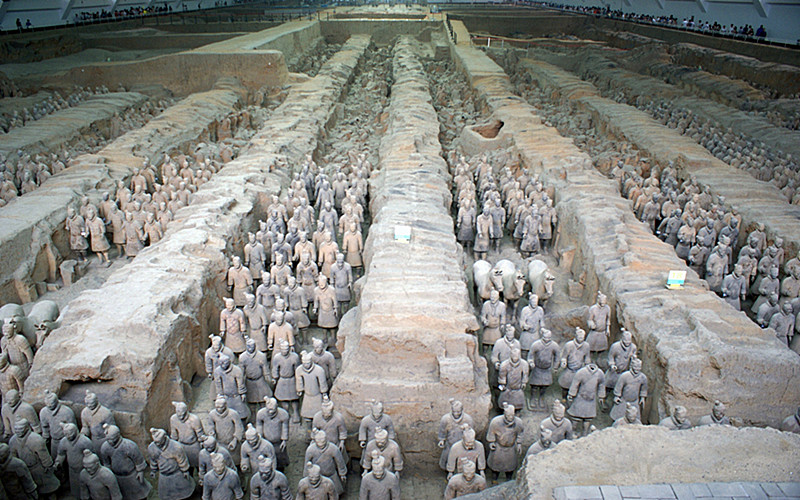The Terra Cotta Warriors Museum of the First Emperor of the Qin Dynasty is also called the Terra Cotta Warriors and the Terra Cotta Warriors of the Qin Dynasty. It is the funerary pit of the the Mausoleum of the First Qin Emperor, and together with the Qinshihuang Mausoleum, it forms the Qinshihuang Mausoleum Museum.
The Terra Cotta Warriors of the Emperor Qin Dynasty is known as the eighth wonder of the world. The over a thousand terracotta warriors unearthed here have different images and vivid expressions, making them a brilliant gem in the history of ancient Chinese sculpture art. They are known as one of the great discoveries in the history of 20th century archaeology.
History of the Terra Cotta Warriors
Emeperor Qin Shihuang began to build his own mausoleum when he ascended to the throne at the age of 13. This project was so massive that it took 720000 manpower and 38 years to complete. In fact, in the year of Emperor Qin Shihuang's death, this cemetery was not completed. After his death, it took Emperor Qin II Hu Hai over a year to finally complete the construction of this cemetery.
It is said that Emperor Qin Shihuang built an underground palace for himself, and the Terra Cotta Warriors are the guards of the underground palace.
The Terra Cotta Warriors of the Qin Dynasty can be described as a typical example of the burial of the Terracotta Warriors. The reason why the Terracotta Warriors reached such a high level of scale and realism is not only due to the wisdom of the craftsmen, but also inseparable from the will of this emperor.
In March 1974, when farmers in Xiyang Village of Shaanxi's Lintong County were digging a well, they accidentally found some fragments of terracotta warriors. After more than a year of exploration and trial excavation by archaeologists, they confirmed that it was a large terracotta warriors pit, which was the world famous Terra Cotta Warriors.
The Museum of the Terra Cotta Warriors and Horses, built on the site of the burial pit of the Terra Cotta Warriors of the Emperor Qin Shihuang, was officially opened in 1979. The main attractions include pits 1, 2 and 3 of the Terra Cotta Warriors of the Qin Dynasty, the bronze chariot and horse exhibition hall and related temporary exhibitions.
What to see?
After checked your ticket, you can visit the three terracotta warriors and horses pits including Pit No. 1, the unearthed cultural relics exhibition room, the bronze chariot and horse exhibition hall, and the Mausoleum of Qin Shihuang.
The terracotta warriors and horses unearthed here can be divided into general warriors, warrior warriors, chariot warriors, etc. based on their different costumes, expressions, and hairstyles. Each terracotta warrior has a different face shape, hairstyle, posture, and expression.The pottery figurines and horses were originally painted, but due to subsequent fire and soaking, most of them have peeled off and changed color.
No. 1 Terracotta Warriors Pit
Excavated earliest, the No.1 pit is about 230 meters long from east to west, and 62 meters wide from north to south. Based on the density of the terracotta warriors and horses unearthed during the test excavation, it is estimated that there are approximately 6,000 terracotta warriors and horses buried in Pit No. 1, as well as a large number of bronze weapons.

Pit No. 1 is also the most shocking exhibition hall that has been put together so far. You can see a huge army of soldier pottery figurines standing in the pit, with different shapes. It is said that there are more than 30 styles of beards alone.Observe carefully, every soldier is lifelike, from the armor to the expressions, from the weapons to the lines on the palms, everything is amazing.
Pit No. 2 and Pit No. 3 Pit
No. 2 and Pit No. 3 are on both sides of Pit No. 1 respectively. Like Pit No. 1, there are nearly 2,000 pottery figurines and horses of similar sizes to real people and real horses.There are different types of troops such as chariots, cavalry and infantry, arranged neatly and orderly.Although it is not as shocking as Pit No. 1, it is still worth a visit because the teams and functions of each figurine pit are different.
The creation of the terracotta warriors and horses is based on real life, with exquisite artistic techniques. The terracotta warriors have different costumes and expressions, and have distinctive personalities and strong characteristics of the times.The bronze weapons unearthed in the pit include swords, beryllium, spears, halberds, halberds, crossbows, and a large number of arrowheads. Most of the weapons are still sharp after more than 2,000 years, indicating that high metallurgical technology was already available at that time.
The Terracotta Warriors and Horses Museum is crowded with visitors every day. You can avoid the peak hours when visiting and start visiting from Pit No. 3. After the tour, you can take the scenic tour bus to the Mausoleum of Qin Shihuang.
Travel Tips
Address: Intersection of Qinling North Road and Qin Terracotta Museum Road in Lintong District, Xi'an City, Shaanxi Province
Phone: 029-81399127029-81399001
Official website: http://www.bmy.com.cn/
Opening hours: 08:30-17:00
Ticket: CNY 120
